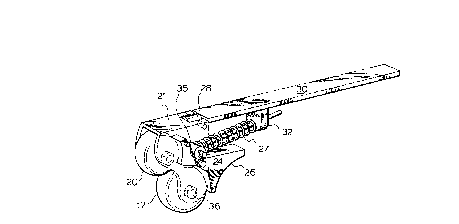Une partie des informations de ce site Web a été fournie par des sources externes. Le gouvernement du Canada n'assume aucune responsabilité concernant la précision, l'actualité ou la fiabilité des informations fournies par les sources externes. Les utilisateurs qui désirent employer cette information devraient consulter directement la source des informations. Le contenu fourni par les sources externes n'est pas assujetti aux exigences sur les langues officielles, la protection des renseignements personnels et l'accessibilité.
L'apparition de différences dans le texte et l'image des Revendications et de l'Abrégé dépend du moment auquel le document est publié. Les textes des Revendications et de l'Abrégé sont affichés :
| (12) Brevet: | (11) CA 2074587 |
|---|---|
| (54) Titre français: | FREINS AVANT POUR PATINS A ROULETTES EN TANDEM |
| (54) Titre anglais: | FRONT WHEEL BRAKE FOR TANDEM WHEELED ROLLER SKATE |
| Statut: | Périmé et au-delà du délai pour l’annulation |
| (51) Classification internationale des brevets (CIB): |
|
|---|---|
| (72) Inventeurs : |
|
| (73) Titulaires : |
|
| (71) Demandeurs : |
|
| (74) Agent: | DENNISON ASSOCIATES |
| (74) Co-agent: | |
| (45) Délivré: | 1997-12-02 |
| (22) Date de dépôt: | 1992-07-24 |
| (41) Mise à la disponibilité du public: | 1994-01-25 |
| Requête d'examen: | 1993-12-13 |
| Licence disponible: | S.O. |
| Cédé au domaine public: | S.O. |
| (25) Langue des documents déposés: | Anglais |
| Traité de coopération en matière de brevets (PCT): | Non |
|---|
| (30) Données de priorité de la demande: | S.O. |
|---|
Patin à roulette comprenant une série de roues, y compris une roue avant munie d'un frein avant constitué d'une roue de freinage située devant la roue avant et d'un dispositif de freinage placé entre la roue de freinage et la roue avant. La roue de freinage n'a pas la même portée que la roue avant étant donné qu'elle se situe au-dessus de cette dernière lorsque le patin est en position de roulement et repose sur toutes ses roues et que la roue de freinage est en position de repos. La roue de freinage peut se déplacer vers l'arrière, de sorte qu'en position de freinage, lorsque le patin est incliné vers l'avant, hors de sa position de roulement, et s'appuie sur la roue de freinage, cette dernière se déplace vers l'arrière afin d'entrer en contact avec le dispositif de freinage. La présente invention prévoit un ressort pour remettre la roue de freinage en position de repos une fois que le patin est de nouveau en position de roulement.
A roller skate with a plurality of skate rollers
including a front roller has a front end brake comprising a
brake wheel forwardly of the front roller with a braking
member between the brake wheel and the front roller. The
brake wheel has a lower reach above that of the front
roller when the skate is in the rolling position on the
rollers and the brake wheel in a brake released position.
The brake wheel is movable rearwardly so that its periphery
is against the brake member in a braking position when the
skate is tipped forwardly away from the rolling position
onto the brake wheel. A spring is provided which moves the
brake wheel back to the brake released position when the
skate is returned to the rolling position.
Note : Les revendications sont présentées dans la langue officielle dans laquelle elles ont été soumises.
Note : Les descriptions sont présentées dans la langue officielle dans laquelle elles ont été soumises.

2024-08-01 : Dans le cadre de la transition vers les Brevets de nouvelle génération (BNG), la base de données sur les brevets canadiens (BDBC) contient désormais un Historique d'événement plus détaillé, qui reproduit le Journal des événements de notre nouvelle solution interne.
Veuillez noter que les événements débutant par « Inactive : » se réfèrent à des événements qui ne sont plus utilisés dans notre nouvelle solution interne.
Pour une meilleure compréhension de l'état de la demande ou brevet qui figure sur cette page, la rubrique Mise en garde , et les descriptions de Brevet , Historique d'événement , Taxes périodiques et Historique des paiements devraient être consultées.
| Description | Date |
|---|---|
| Le délai pour l'annulation est expiré | 2000-07-24 |
| Lettre envoyée | 1999-07-26 |
| Accordé par délivrance | 1997-12-02 |
| Inactive : Dem. traitée sur TS dès date d'ent. journal | 1997-09-24 |
| Inactive : Renseign. sur l'état - Complets dès date d'ent. journ. | 1997-09-24 |
| Préoctroi | 1997-07-25 |
| Un avis d'acceptation est envoyé | 1997-01-28 |
| Demande publiée (accessible au public) | 1994-01-25 |
| Toutes les exigences pour l'examen - jugée conforme | 1993-12-13 |
| Exigences pour une requête d'examen - jugée conforme | 1993-12-13 |
Il n'y a pas d'historique d'abandonnement
Le dernier paiement a été reçu le 1997-07-22
Avis : Si le paiement en totalité n'a pas été reçu au plus tard à la date indiquée, une taxe supplémentaire peut être imposée, soit une des taxes suivantes :
Les taxes sur les brevets sont ajustées au 1er janvier de chaque année. Les montants ci-dessus sont les montants actuels s'ils sont reçus au plus tard le 31 décembre de l'année en cours.
Veuillez vous référer à la page web des
taxes sur les brevets
de l'OPIC pour voir tous les montants actuels des taxes.
| Type de taxes | Anniversaire | Échéance | Date payée |
|---|---|---|---|
| TM (demande, 5e anniv.) - petite | 05 | 1997-07-24 | 1997-07-22 |
| Taxe finale - petite | 1997-07-25 | ||
| TM (brevet, 6e anniv.) - petite | 1998-07-24 | 1998-07-21 |
Les titulaires actuels et antérieures au dossier sont affichés en ordre alphabétique.
| Titulaires actuels au dossier |
|---|
| MARIO DE SANTIS |
| Titulaires antérieures au dossier |
|---|
| S.O. |